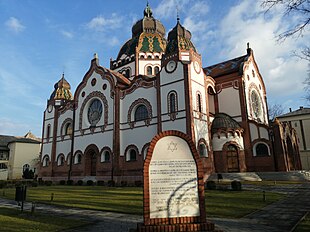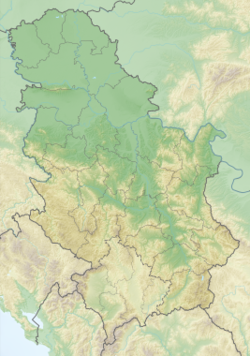The Subotica Synagogue, officially the Jakab and Komor Square Synagogue in Subotica (Serbian: Синагога на тргу Јакаба и Комора, Суботица; Hungarian: Jakab és Komor téri zsinagóga, Szabadka), is a former Neolog Jewish congregation and synagogue, located in Subotica, Serbia.
| Subotica Synagogue Jakab and Komor Square Synagogue in Subotica | |
|---|---|
 The former synagogue in 2020, after renovation | |
| Religion | |
| Affiliation | Neolog Judaism (former) |
| Rite | Nusach Ashkenaz |
| Ecclesiastical or organizational status | Synagogue (1903–1976) |
| Status | Closed |
| Location | |
| Location | Jakab and Komor Square, Subotica-Szabadka |
| Country | Serbia |
Location of the former synagogue Serbia | |
| Geographic coordinates | 46°06′13″N 19°40′04″E / 46.10361°N 19.66778°E |
| Architecture | |
| Architect(s) |
|
| Type | Synagogue architecture |
| Style | Hungarian Art Nouveau |
| Date established | c. 1890s (as a congregation) |
| Completed | 1903 |
| Specifications | |
| Height (max) | 40 m (130 ft) |
| Dome(s) | One |
| Dome height (outer) | 40 m (130 ft) |
| Dome height (inner) | 23 m (75 ft) |
| Dome dia. (outer) | 12.6 m (41 ft) |
| Type | Cultural Monument of Exceptional Importance |
| Designated | 1975 |
| Reference no. | СК 1035 |
| [1][2] | |
Completed in 1903 in the Hungarian Art Nouveau style, the synagogue is the second largest synagogue in Europe after the Dohány Street Synagogue in Budapest.[3][4] The synagogue was built during the administration of the Kingdom of Hungary (part of Austria-Hungary), according to the plans of Marcell Komor and Dezső Jakab, and replaced a smaller and less elaborate synagogue. It is one of the finest surviving pieces of religious architecture in the art nouveau style.[5]
The former synagogue was designated a Monument of Culture in 1974; in 1990 it was designated a Monument of Culture of Exceptional Importance, and it is protected by Republic of Serbia. After a long period of neglect, the former synagogue was renovated and reopened as a concert venue in 2018.
Overview
editThe synagogue of Subotica is the only surviving Hungarian Art Nouveau Jewish place of worship in the world. Erected by a prosperous Jewish community, with approximately 3,000 members, between 1901 and 1903, it highlighted the double, Hungarian-Jewish identity of its builders, who lived in a multi-ethnic, but predominantly Roman Catholic city, which was the third largest of the Hungarian Kingdom and the tenth largest of the Habsburg Empire.
The community hired Dezső Jakab and Marcell Komor, not well established in their practice, who would later make a significant imprint on the architecture of Subotica and Palić, the resort town near the city. The architects were ardent followers of Ödön Lechner, the father of Hungarian Art Nouveau-style architecture, and later partisans of this movement, which unified Hungarian folklore elements with some Jewish structural principles and sometimes even Jewish motifs.[citation needed]
Besides lending the synagogue a distinct double identity in architectural terms, Jakab and Komor created a new space-conception of synagogue architecture in Hungary and deployed modern steel structure as well as an advanced technique of vaulting. Unlike period synagogues in Hungary that featured a predominantly basilica-like arrangement with a nave and two aisles, with or without a dome, this synagogue achieves a unified, tent-like central space under the sun, painted in gold on the apex of the dome. The women's gallery and the dome are supported by four pairs of steel pillars covered with gypsum with a palm leaf relief. The large dome is a self-supporting, 3-to-5-centimetre (1.2 to 2.0 in) thin shell-structure, formed in the spirit of Hungarian folklore. While many other synagogues utilized light structures, they usually mimicked traditional arches and vaults. The novelty of this synagogue is the sincere display of modern structure and modernity in general, of which Jews have been important advocates and generators.[citation needed]
The former synagogue was renovated in a multi-million project, financed mainly by the Hungarian and Serbian governments, and opened in March 2018. The former synagogue is owned by the municipality, and is a tourist attraction and concert venue, available to the small local Jewish community as a synagogue for services and other purposes.[6]
Gallery
edit-
Synagogue during the early half of the 20th century
-
Synagogue during the early half of the 20th century
-
Synagogue before renovation
-
Synagogue exterior (January 2003)
-
Synagogue exterior (April 2008)
-
Synagogue exterior (2020)
-
Dome
-
Dome interior
-
The main entrance
-
Synagogue Interior during renovation
-
Stained glass window inside
-
Stained glass window
-
Menorah lamp
See also
editReferences
edit- ^ "Subotica Synagogue". World Monuments Watch. World Monuments Fund. May 2021. Retrieved 23 March 2024.
- ^ "Subotica Synagogue". srbija-projektieu.rs. Retrieved 25 November 2023.
- ^ "Druga najveća sinagoga u Evropi nalazi se u Srbiji i KONAČNO će biti obnovljena" (in Serbian). 9 March 2017.
- ^ Subotić, Jelena (2019). Yellow Star, Red Star: Holocaust Remembrance after Communism. Ithaca, NY & London: Cornell University Press. p. 222. ISBN 9781501742408.
- ^ "Subotica". Duke University. Archived from the original on 2008-05-14. Retrieved 2008-05-14.
- ^ "Serbia: magnificent Subotica synagogue officially reopened". Jewish Heritage Europe. 27 March 2018.
External links
edit- Steinberg, Connie, ed. (n.d.). "An Audience With Her Majesty". Synagogues with Jews. Archived from the original on 2007-10-28.
